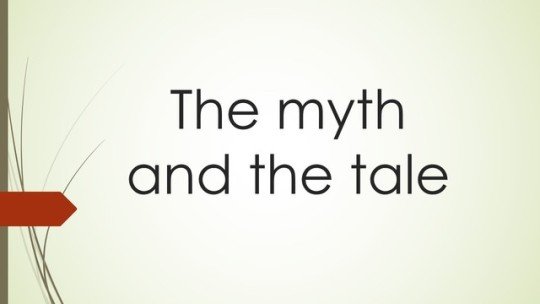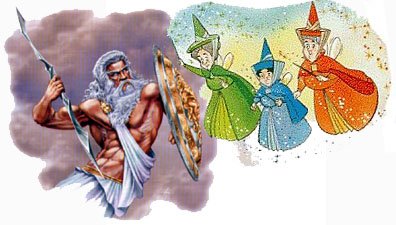Extracted from my bachelor degree thesis.

Pic of my own creation
Introduction
In the previous post we exposed oral tradition as one of the main sources of transmission of the generational knowledge from a general perspective, mentioning its three main aspects: tale, legend and myth.
Today we are going to talk about the first slope, the tale, which has as many similarities as differences with the myth, features that constitute a true challenge for scholars when it comes to setting a clear and precise definition of what is a myth and what is a tale. Russian folklorist Vladimir Propp had already warned about this situation during his investigation into the historical roots of the fairy tale. According to this author, the myth cannot be distinguished from the fairy tale since there are times where both coincide so perfectly that in ethnology and folklore such myths are frequently called "tales" (2008: 29).
Despite the warning of Propp on this uniqueness, scholars are still engaged in the task of establishing a distinction between both genres. About this, Evia Cervantes mentions that, in order to analyze the differences between the myth and the tale, it is necessary to start with the similarities between both genres (2007: 101). Based on these similarities, then, it is possible to establish the difference between the two categories, which gradually will be presented clearly so the specialist as to the amateur.
Myth and tale: similarities and differences
The similarities lie in their content, which is set within the framework of the fantastic and the wonderful, in their quality as creations of the human imagery, in the intervention of supernatural beings in it, and the fact that their author is, almost all the time, unknown. By identifying these similarities, we go to to see what are the differences that separate them, same that are identified widely by some specialists as Kirk (2006), Propp (2008) and Eliade (2000), among other scholars.
Kirk mentions that there is a distinction between the myth and the tale, which was already noticeable in the oral tradition of the primitive cultures. This distinction refers to the role that wield both types of narrative: on the one hand, the myth works as a story of the past, a story that makes reference to a famous person or a historical period in particular. On the other hand, the tale has the function of entertainment where the listener listens to someone narrating stories related to travels, shipwrecks, or achievements of certain characters (2006: 52).
Eliade makes a similar reference when he mentions that there is a distinction between those which he calls "true stories" (myths) and "false stories" (tales) in North American indigenous peoples. The "true story" is the story about the origins of the world; its characters are divine, supernatural, celestial and astral beings. The "false history", on the other hand, is the story about the achievements, in any way edifying, over some specific animal (2000: 19).
Meanwhile, Propp declares that the myth and the tale, despite their similarity, are practically distinguishable not by their form, but by their social function, i.e.: the myth is a story about the divinity or divine beings in who the people actually believe to exist; therefore, the tale is a story whose origin lies in the same myth (2008: 29) and, in addition, its function is to delight the listener with the marvelous.
Perhaps the author who still offers more clear distinctions between these two categories is Lévi-Strauss, who states that, in the tale, the actions of the characters do not present frequently any reason or cause to be carried out, while in the myth the reasons are expressed through the divine. Likewise, he argues that the tales are built on local, social and moral binary oppositions while the myths are built on cosmological, metaphysical and natural binary oppositions (2000: 120 - 125).
Evia Cervantes, therefore, points out that the myth and the tale are distinguished by two clearly perceptible aspects: the time management and the solution of the dangerous situations. While in the myth time is set as indefinite, in the tale the temporality does not exist, so anything can happen at any time; if time is present on the narrative, it will always make reference to the past. Regarding the settlement of the conflict, the mythical hero will always appeal to the divinity or use some magical elements that would lend their support, while the protagonist in the tale, the hero relies on wit and strategy (2007: 102).
Therefore, if the story contains both similar elements as different to the myth, how would be the case of the legend?
The answer to that question will be exposed... In the next post.
.-.-.-.-.
Cited sources
- Elíade, Mircea (2000) Aspectos del mito. España: Paidós/Orientalia.
- Evia Cervantes, Carlos (2007) El mito de la serpiente Tsukán. Mérida, Yucatán, México: Universidad Autónoma de Yucatán.
- Kirk, G.S. (2007) El mito: Su significado y funciones en la Antigüedad y otras culturas. España: Paidós.
- Lévi-Strauss, Claude (1976) Antropología Estructural. Buenos Aires: EUDEBA.
- Propp, Vladimir (2008) Raíces Históricas del Cuento. Madrid: Ediciones Akal.
.-.-.-.-.
Part III
.-.-.-.-.
Spanish version / versión española
.-.-.-.-.

GIF created by @fabiyamada

Hi! I am a robot. I just upvoted you! I found similar content that readers might be interested in:
https://www.britannica.com/topic/myth
Hello! I have an issue: I was reviewing the article you think it's similar and it is not similar to the article. The sources I've used here were from the books listed at the end of the post.